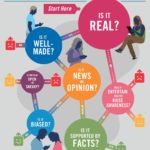A free press is essential to the success of a democracy. As the media has evolved over time to include radio, television, internet and now smart phones and social media apps, the ability in “being capable to read them” needs examining. This lesson guides students through analysis of social media posts, the definition of terms relevant to the media, and provides tools for identifying quality sources for examination of current political issues. This lesson accompanies the Talking Turkey: Taking the ‘Dis’ Out of Civil Discourse program as well as YLI and American Evolution’s First Freedom Wall. Free registration is required to access the lesson plan.
Bell Ringer: Social Media and Democracy
Students learn about the effects of social media on society including the impact on civic engagement and social disintegration.
Public Participation Goes Viral
Social media revolutionized how the public and candidates interact – but how effective are the latest tools for shaping election outcomes?
Amendment Worth A Thousand Words
With many pictures posted all over every social media platform, the #amendmentworthathousandwords’ overall mission will be to enlighten many of the rights promised to people by the Constitution. Through this challenge, many will become aware of their rights and what the Constitution does not only for them, but for all Americans as well! Lesson plan by Eboni Jenerette
Is This Story Share-Worthy? Flowchart
NewsFeed Defenders
NewsFeed Defenders is a challenging online game that engages players with the standards of journalism, showing you how to spot a variety of methods behind the viral deception we all face today. Join a fictional social media site focused on news and information, and meet the challenge to level up from guest user to site admin. This can only be achieved by spotting dubious posts that try to sneak in through hidden ads, viral deception, and false reporting. In addition to maintaining a high-quality site, you are charged with growing traffic while keeping the posts on topic.
Dealing With Controversial Issues/Social Studies in Action Library
This program examines how social studies teachers in any grade level can encourage open and informed discussions with their students while dealing with controversial issues. Topics range from stereotypes and gender–based discrimination to the conflict in the Middle East. Through clearly identifying issues, listening to multiple perspectives, and formulating personal positions, teachers explore strategies that can be used to teach challenging issues such as these in their own classrooms.
Free Speech Essentials
Do your students know what they’re free to say online? At school? On a public street corner? From censorship to cyberbullying, the First Amendment and the freedoms it protects are as hotly contested as ever. This EDCollection explores 16 free speech debates ranging from the founding of our nation to recent headlines to illustrate what free speech actually means, where it comes from, and how far it can go. Whether you’re a social studies teacher looking for a complete unit or an English teacher looking to spend a single class period on free expression, there’s something for everyone. Free registration required.
Civic Art Project: From Her Beacon
Students will work collaboratively to create a mural of the Statue of Liberty to show the statue as a representation of freedom and a symbol of welcome to immigrants coming from other countries. This lesson can be adapted for different grade levels. High school students will read a poem and incorporate some of its ideas into their mural. Elementary and middle school students will incorporate words and phrases inspired by the statue into their mural. This activity supports Art, Social Studies, Civics, and English Language Arts standards and can be used as a cross-curricular project across these classrooms. Teachers across the curricula are encouraged to work together to bring this activity to life.
African American History Month Resources
African American History Month evolved from the birthdays of Abraham Lincoln and Frederick Douglass in the second week of February. Historian and author Dr. Carter G. Woodson framed the concept that became the first Negro History Week in February 1926. It developed into a monthlong commemoration of the struggles and triumphs of the African American community. On this page, learn the stories of Autherine Lucy Foster, the first African American student to attempt to integrate the University of Alabama; Frank M. Johnson, Jr., the federal judge who ruled in the Rosa Parks case; and Linda Brown, the 9-year-old who became the face of children caught in the crossfire of the fight for social change. The Pathways to the Bench video series features profiles of African American federal judges who offer perspectives on their experiences during the Civil Rights era.
